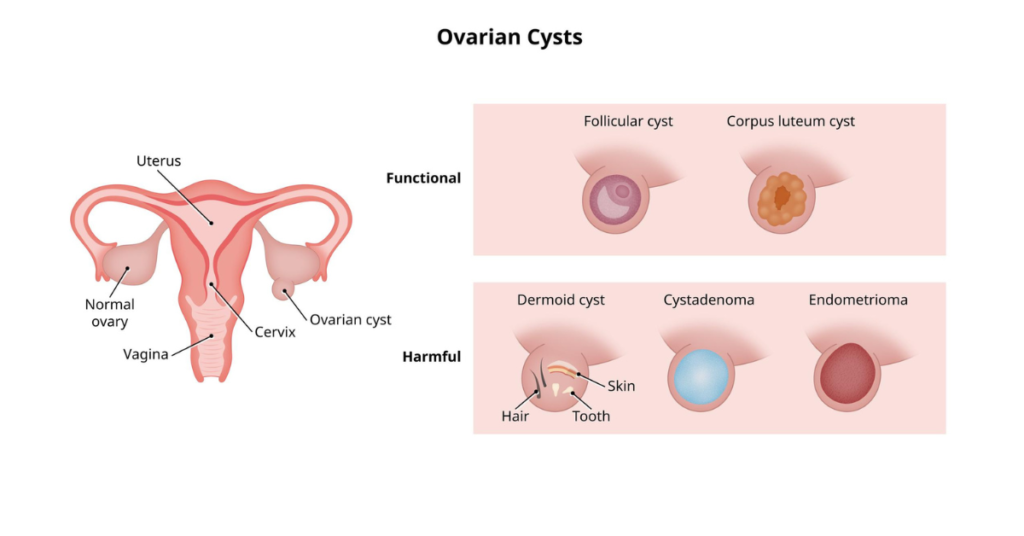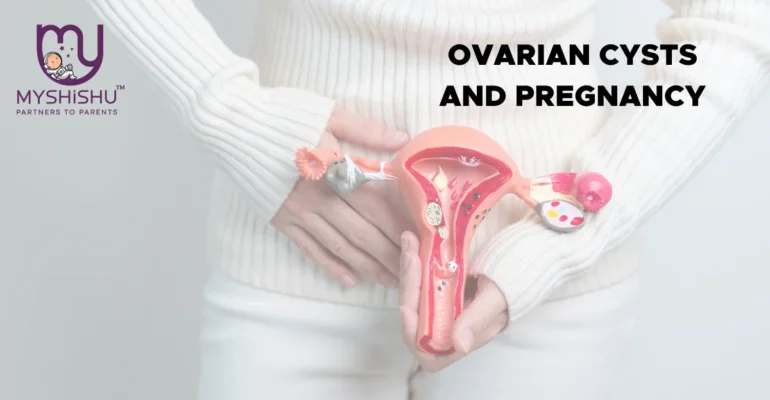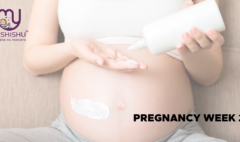OVARIAN CYSTS AND PREGNANCY- A COMPREHENSIVE GUIDE
OVARIAN CYSTS AND PREGNANCY- A COMPREHENSIVE GUIDE
An ovarian cyst is a sac that contains fluid or semisolid material, which can form on one or both of your ovaries. The ovaries are small organs located in your pelvis that produce hormones like estrogen and progesterone, and hold the egg cells. Ovarian cysts are a common occurrence, and many women may experience them at some point in their lives.
Most ovarian cysts can be identified by ultrasound or other imaging tests. These tests can also help physicians determine their size. The presence of ovarian cysts can sometimes impact pregnancy, but the extent of the impact will depend on factors such as the type of ovarian cyst, its size, and whether it causes symptoms. Let’s take a look at the different types of cysts.
TYPES OF OVARIAN CYSTS:
There are different types of ovarian cysts, which are as follows:
- FOLLICULAR CYSTS
Follicular cysts are functional cysts that form in response to changes in the menstrual cycle. They are fluid-filled sacs that can develop either inside or on the ovaries. Women of reproductive age are more prone to develop these cysts, which typically occur as a result of ovulation. - CORPUS LUTEUM CYSTS
During each menstrual cycle, a sac in one of the ovaries called the follicle produces and releases an egg. Soon after, a group of cells called the corpus luteum forms at the site of the ruptured follicle from where the egg was released. If the egg gets fertilized, the corpus luteum will continue to grow and produce a hormone called progesterone, which prepares the uterus for pregnancy. However, in some cases, a corpus luteum cyst may form in the ovaries when the corpus luteum keeps growing instead of breaking down. - OVARIAN CYSTADENOMA
Cystadenomas are benign ovarian tumors of epithelial origin. The two main types are serous and mucinous. - DERMOID CYSTS
Ovarian dermoid cysts are a type of cyst that contains fully developed tissues such as skin, hair, and teeth. Even though these cysts are typically non-cancerous, they can lead to complications. If there is a risk of the cyst causing damage to the ovary or rupturing, it is recommended to have it removed by a healthcare professional. - ENDOMETRIOID CYSTS
The endometrium is the inner lining of the uterus, which thickens, breaks down, and bleeds during menstrual cycles. However, this type of tissue can sometimes grow in other places like the bladder, fallopian tubes, and peritoneum. When this happens, it can lead to endometriosis, a condition where the tissue doesn’t leave the body but continues to grow in places where it shouldn’t. When endometriosis affects the ovaries, cysts called endometriomas may develop, and surrounding tissues can become irritated, causing the formation of scar tissue. This condition can cause pain, particularly during menstrual periods, and can lead to fertility problems. However, treatments are available to help manage the condition and its complications.

EXPLORE THE SYMPTOMS OF OVARIAN CYSTS
Ovarian cysts generally do not cause any symptoms. However, if the cysts grow, certain symptoms may appear. These symptoms may include:
- Pelvic pain before or during menstrual cycle
- Painful intercourse
- Pain in the lower back and thigh
- Nausea and vomiting
- Indigestion and painful bowel movements
- Feeling of bloating
Please note that it is always important to consult a healthcare professional if you experience any of these symptoms.
CASES IN WHICH OVARIAN CYSTS GETS COMPLICATED
- Cancerous cyst. Ovarian cysts that form after menopause are more likely to be cancerous than those that form before.
- Ruptured ovarian cyst. Functional cysts may rupture without symptoms, but larger cysts can cause severe pain and swelling in the belly.
- Ovarian torsion. Cysts have the potential to grow to a size where they can alter the shape of your ovary. This can significantly increase the chances of it getting twisted, which in turn can prevent the flow of blood to your ovary, leading to its death. Some of the most common symptoms of ovarian torsion include intense pain, nausea, and vomiting.
One should seek medical assistance right away if you’re experiencing the symptoms of a ruptured ovarian cyst or ovarian torsion.
DIAGNOSING OF OVARIAN CYSTS
The diagnosis of ovarian cysts involves a medical history assessment, physical examination, and imaging tests. During your consultation, the doctor will ask about any symptoms you may be experiencing, such as pelvic pain, menstrual irregularities, or abdominal discomfort. Information about your menstrual cycle, past medical conditions, surgeries, and family history of ovarian cysts or ovarian cancer may be relevant.
A common way to examine the ovaries and identify cysts is by using transvaginal ultrasound. This procedure involves inserting a probe into the vagina to obtain clear images of the ovaries. It helps to detect the presence, size, location, and characteristics of any cysts. If ultrasound reports don’t provide conclusive evidence, then an MRI or CT scan is recommended for further evaluation.
The healthcare provider performs a pelvic exam to feel for any abnormal growths or changes in the ovary’s size or shape. Not all cysts are detectable through physical examination alone. The CA-125 blood test is used to measure the amount of a protein called CA-125 in the blood. This test is often used to check for ovarian cancer or other conditions affecting the ovaries. However, elevated CA-125 levels can also be caused by other factors, so this test is not always relied upon as the sole method of diagnosing ovarian cysts.
If a cyst is small, not causing any symptoms, and appears to be harmless based on imaging, the doctor may suggest monitoring it through follow-up ultrasounds at regular intervals to observe any changes in size or characteristics. However, if a cyst appears suspicious or requires further examination, the doctor may recommend a biopsy or surgical removal for detailed analysis.
When it comes to fertility, certain types of ovarian cysts can impact it, especially endometriomas or cysts caused by endometriosis. These cysts can lead to pelvic adhesions, which may make it more difficult to conceive or disturb the normal functioning of the ovaries. During pregnancy, if an ovarian cyst twists or ruptures, it can cause extreme discomfort. Although most ovarian cysts do not cause problems during pregnancy, there is still a risk of rupture or torsion, which may require medical attention.
During early pregnancy, functional ovarian cysts may continue to grow due to hormonal changes. However, they typically resolve on their own and do not interfere with the pregnancy. Ovarian cysts can, in rare cases, cause issues during pregnancy, such as ovarian torsion, which can be extremely painful and require immediate medical attention. Large cysts may also increase the risk of miscarriage or premature labor.
If a woman with ovarian cysts is pregnant or trying to conceive, it is important to have regular medical check-ups and careful observation by a medical professional. Most cysts do not require treatment during pregnancy, but routine checkups and ultrasounds are necessary to ensure that the cysts do not pose a threat to the mother’s health or the fetus.
WHAT CAUSES AN OVARIAN CYSTS DURING PREGNANCY?
The corpus luteum is a small structure that forms in the ovary after ovulation. Its main function is to produce hormones, which are essential for nourishing and supporting the uterine lining and the developing fetus until the placenta takes over around 10 weeks into pregnancy. However, sometimes a fluid-filled sac, called a corpus luteum cyst, may form instead of regressing.
In most cases, a corpus luteum cyst is harmless and requires no treatment. If you are pregnant, the cyst will usually disappear during the second trimester. If you are not pregnant, the cyst may go away on its own within a few weeks. Generally, by the time you have your third menstrual cycle, the cyst will have disappeared.
However, if you experience any symptoms, such as pain or discomfort, your healthcare provider may suggest some treatments to help manage them. These may include resting, taking pain medications, and avoiding sexual intercourse if it worsens your pain.
In rare cases where the cyst is so large that it could harm your ovary or pose risks during pregnancy, your healthcare provider may consider removing it.
HOW CYSTS IS TREATED DURING PREGNANCY
It’s unlikely that you will require any treatment for a corpus luteum cyst. If you’re pregnant, the cyst will most likely disappear during your second trimester. If you’re not pregnant, the cyst may go away on its own within a few weeks. Typically, by the time you complete your third menstrual cycle, the cyst will have disappeared.
If you have an ovarian cyst, your healthcare provider can offer treatment to help you manage any symptoms you may be experiencing. Some of the recommended treatments may include rest, pain medications, and pausing sexual intercourse if it’s worsening your pain. If your cyst grows too large and it could potentially harm your ovaries, your healthcare provider may recommend further medical intervention.
WHAT CARE SHOULD BE TAKEN IN CASE OF CORPUS LUTEUM CYSTS?
It’s important to seek emergency care if your cyst grows so big it twists your ovary, causing ovarian torsion. If you experience any of the following symptoms, it’s best to get help right away:
- Persistent nausea and vomiting with pelvic pain.
- Severe pain in your shoulder.
- Feeling light-headed or dizzy, like you’re about to faint.
- Stabbing pain in one side of your abdomen or pelvic area.
However, it’s important to remember that corpus luteum cysts are mostly harmless masses that typically grow and disappear without causing any problems or complications.










